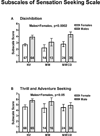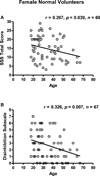Former heroin addicts with or without a history of cocaine dependence are more impulsive than controls
- PMID: 22265192
- PMCID: PMC3372650
- DOI: 10.1016/j.drugalcdep.2011.12.022
Former heroin addicts with or without a history of cocaine dependence are more impulsive than controls
Abstract
Background: Personality traits such as impulsivity and sensation seeking may contribute to the initiation and maintenance of illicit drug use. Since studies have reported higher impulsivity and sensation seeking traits in cocaine dependent subjects, we were interested in determining whether former heroin addicts in methadone pharmacotherapy with comorbid cocaine addiction have greater impulsivity than those without.
Methods: Instruments to assess impulsivity (Barratt Impulsiveness Scale version 11) and sensation seeking (Sensation Seeking Scale version V) were administered to former severe heroin addicts meeting Federal criteria for methadone maintenance pharmacotherapy with (n = 71) or without cocaine dependence (n = 31) and to 145 normal healthy (non-methadone-maintained) volunteers.
Results: The methadone-maintained without cocaine dependence and the methadone-maintained with cocaine dependence groups, both scored higher than did the normal volunteer group on the Barratt Impulsiveness Scale total score (p<0.001). On the Barratt Impulsiveness Scale Attentional, Nonplanning, and Motor subscales, the methadone-maintained and methadone-maintained with cocaine dependence groups scored higher than did normal volunteers with no history of drug abuse or dependence (p<0.001). There was no difference among groups on total score or any subscale of the Sensation Seeking Scale. However, males in all groups overall scored higher than did females on Disinhibition and Thrill and Adventure seeking subscales of the Sensation Seeking Scale version V (p<0.001).
Conclusions: This study demonstrates higher impulsivity in former severe heroin addicts meeting criteria for or currently in stable methadone maintenance pharmacotherapy, irrespective of a positive or negative history of cocaine dependence.
Copyright © 2012 Elsevier Ireland Ltd. All rights reserved.
Conflict of interest statement
No conflict declared.
Figures



Similar articles
-
Glucocorticoid negative feedback in methadone-maintained former heroin addicts with ongoing cocaine dependence: dose-response to dexamethasone suppression.Addict Biol. 2006 Mar;11(1):84-96. doi: 10.1111/j.1369-1600.2006.00006.x. Addict Biol. 2006. PMID: 16759341
-
Comparison between heroin and heroin-cocaine polyabusers: a psychopathological study.Ann N Y Acad Sci. 2006 Aug;1074:438-45. doi: 10.1196/annals.1369.044. Ann N Y Acad Sci. 2006. PMID: 17105942
-
Promoting abstinence from cocaine and heroin with a methadone dose increase and a novel contingency.Drug Alcohol Depend. 2009 Apr 1;101(1-2):92-100. doi: 10.1016/j.drugalcdep.2008.11.006. Epub 2008 Dec 19. Drug Alcohol Depend. 2009. PMID: 19101098 Free PMC article. Clinical Trial.
-
Multimodal drug addiction treatment: a field comparison of methadone and buprenorphine among heroin- and cocaine-dependent patients.J Subst Abuse Treat. 2006 Jul;31(1):3-7. doi: 10.1016/j.jsat.2006.03.007. J Subst Abuse Treat. 2006. PMID: 16814005 Review.
-
[What effects does methadone maintenance treatment have on the rehabilitation of heroin addicts?].Tidsskr Nor Laegeforen. 1998 Aug 30;118(20):3139-41. Tidsskr Nor Laegeforen. 1998. PMID: 9760857 Review. Norwegian.
Cited by
-
Examining delay discounting of condom-protected sex among opioid-dependent women and non-drug-using control women.Drug Alcohol Depend. 2014 Nov 1;144:53-60. doi: 10.1016/j.drugalcdep.2014.07.026. Epub 2014 Jul 30. Drug Alcohol Depend. 2014. PMID: 25190049 Free PMC article.
-
Behavioral predictors of individual differences in opioid addiction vulnerability as measured using i.v. self-administration in rats.Drug Alcohol Depend. 2021 Apr 1;221:108561. doi: 10.1016/j.drugalcdep.2021.108561. Epub 2021 Jan 29. Drug Alcohol Depend. 2021. PMID: 33588371 Free PMC article. Review.
-
Addictions and Personality Traits: Impulsivity and Related Constructs.Curr Behav Neurosci Rep. 2014 Mar 1;1(1):1-12. doi: 10.1007/s40473-013-0001-y. Curr Behav Neurosci Rep. 2014. PMID: 24772382 Free PMC article.
-
Behavioral Risk Factors for HIV Infection in Hospitalized Persons Who Co-use Stimulants and Opioids.AIDS Behav. 2022 Apr;26(4):1047-1055. doi: 10.1007/s10461-021-03460-0. Epub 2021 Sep 12. AIDS Behav. 2022. PMID: 34510289 Free PMC article.
-
Neural correlates of adherence to extended-release naltrexone pharmacotherapy in heroin dependence.Transl Psychiatry. 2015 Mar 17;5(3):e531. doi: 10.1038/tp.2015.20. Transl Psychiatry. 2015. PMID: 25781230 Free PMC article.
References
-
- Allen TJ, Moeller FG, Rhoades HM, Cherek DR. Impulsivity and history of drug dependence. Drug Alcohol Depend. 1998;50:137–145. - PubMed
-
- Andrucci GL, Archer RP, Pancoast DL, Gordon RA. The relationship of MMPI and sensation seeking scales to adolescent drug use. J. Pers. Assess. 1989a;53:253. - PubMed
-
- Andrucci GL, Archer RP, Pancoast DL, Gordon RA. The relationship of MMPI and Sensation Seeking Scales to adolescent drug use. J. Pers. Assess. 1989b;53:253–266. - PubMed
-
- Aron AR. The neural basis of inhibition in cognitive control. Neuroscientist. 2007;13:214–228. - PubMed
-
- Ball SA, Carroll KM, Rounsaville BJ. Sensation seeking, substance abuse, and psychopathology in treatment-seeking and community cocaine abusers. J. Consult. Clin. Psychol. 1994;62:1053–1057. - PubMed
Publication types
MeSH terms
Substances
Grants and funding
LinkOut - more resources
Full Text Sources
Medical

